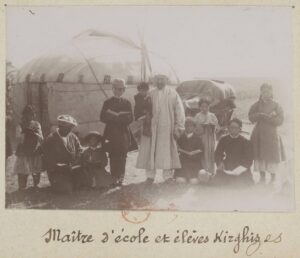English transcript of the video presentation below
Today I am going to talk about one particular type of traditional Kazakh clothing: the headdress of a bride, called a saukele.

Presenter

Inga STASEVICH, Senior Researcher at Peter the Great Museum of Anthropology and Ethnography (the Kunstkamera). Her area of expertise includes ethnography of peoples of Central Asia, study of traditional material and spiritual culture, regional specifics of Central Asian Islam, gender aspects of culture, and modern ethnic processes, in particular forms of traditional culture adaptation in today’s world.
The video material has been produced by Doroga Ludei, (“The Way of the People”), a project that combines a series of documentaries and video lectures from the scholars and specialists in the field of history, philology, literature and philosophy. The project is devoted to the problems of the history of the Central Asian region.
The wedding dress was always very important, as a girl had to be properly dressed when leaving her parents’ home for the house of her future spouse. For the wedding, a girl had to wear all the jewelry that she had, as each piece of jewelry had its own symbolic meaning. So the saukele itself had many implicit mythological symbols, and in my talk I want to decipher the world of these mythological symbols and how they fit into Kazakh culture.


Just as every culture is unique, so too are its objects of decorative and applied art, oral and folk art, and original customs and rituals. Today we will talk about traditional Kazakh culture, and we will turn to one particular item of the traditional Kazakh culture: the saukele, the headdress of a Kazakh bride. We will touch upon issues related to its origins and try to ‘read’ this item.
What does it mean to read an item? We will try to decipher the hidden symbols found in traditional Kazakh myths, and we will try to look into the mysterious world of mythological images.
The saukele is a richly decorated headdress, and it was not affordable for all. In the end of the 19th and beginning of the 20th century, it could cost as much as 5000 silver rubles. A saukele had to be ordered in advance of the wedding, usually one or one and a half years prior—after the matchmaking (engagement) was already completed and the girl had become a bride waiting for a wedding. At that moment, her family would order a saukele from the jeweler.
There are no two identical saukele. Each jeweler adorned and decorated this headpiece in their own way. Some saukeles have region-specific characteristics, so, for instance, a western Kazakh saukele is distinguished by the massive, often anthropomorphic metal linings in the central part of the headpiece. In the southern saukele, its textile decoration elements were more visible. And yet, saukeles always had universal elements of design and decor, which were repeated from time to time. For example, the cone-like, high shape of the headdress is a hallmark of the piece and the hats could reach a height of 70 centimeters. They were usually made of white felt because it was considered a good quality and expensive material, and the felt was sheathed on top with other fabrics such as cloth, velvet, or silk, but always red in color. Why red? The red color has always been a symbol of fertility; it is a sign of a woman at the peak of her fertile age, and it signifies a wish of many children for a young bride.


Inside each saukele, there is a three-lobed quilted cap, very similar in shape to the lining under a helmet, which we will explain a little later. An embroidered strip behind the saukele is usually quite long and richly decorated. Some researchers believe that this strip is a nakosnik, a triangular decoration hung on the end of the braid. It’s true that, in ancient times (as the saukele traces its history back to quite ancient times), women had to hide their hair after they got married, ensuring that no stranger could see it. Unmarried girls and women could walk with their hair loose or with braids, but after marriage, they had to hide it. So with time, the nakosnik—which covered the braid behind the saukele—has become an embroidered strip, or a false nakosnik. On the both sides of the saukele, there are surprisingly richly decorated pendants called jahtau. They always include precious stones and beads such as coral, pearls, and glass. Behind the saukele we see a scarf called a jelek. This is a veil that covers the shoulders of the bride, and sometimes her face.


The saukele has an amazing, unique shape not seen in other cultures, as it has a cone-shaped form, and in some ways, it reminds us of ceremonial helmets.
Why is this so, and why does the girl wear a headpiece so reminiscent of a man’s military headgear, a helmet?
Additionally, there is another detail in a woman’s dress, a swing skirt called a beldemchi (although this skirt was worn by a married woman), which would also bring to mind a man’s military skirt, like those seen in epic texts and worn by the Turkic military. Some written archaeological sources suggest that these pointed, conical headdresses were characteristic of the Scythian-Sarmatian time. The images of men’s tall headdresses from that era are very similar in shape to the saukele. Even a well-known golden man found in the Issyk mound and dated back to 9th or 10th centuries BC was wearing a kulah, a high conical headpiece richly decorated with gold plates in a three-part structure of decoration, like saukele.
This even led some researchers to believe that the Issyk golden man is in fact a woman who is dressed in a ceremonial military costume.

Is there any explanation to this? Why are the wedding hats so similar to men’s military hats? Perhaps it relates to the fact that the upbringing of Kazakh girls had been somewhat Amazonian. In various cultures of Kazakshtan, we see an image of an epic virgin warrior. She challenges her potential fiancé to a fight, and only after securing victory over the girl did the groom gain the right to marry this female warrior. A victory over the girl was almost the same as the consummation of marriage, or the deprivation of a girl’s virginity. Even if this remains a legend, the upbringing of the Kazakh girl has always been liberal enough, as she had to become a worthy wife by matching her husband in bravery and skills. Girls had to be good in the saddle, participate in competitions, stand up for themselves, and be confident in musical and oratory challenges on an equal footing with young men. Simply consider the historical competition known as kyz kuu, in which the young man had to catch the young woman on a horse, and a young woman has always been the leading character in these types of competitions.

This certainly reminds us of an Amazon, a free girl on a horse. But the freedom ends with the moment of marriage, as the girl is deprived of this freedom. She then has to be submissive and respectful towards her elders and be a proper kelin, or daughter-in-law. There are several prohibitions for her, both verbal and behavioral. These prohibitions are undoubtedly difficult, and last, as a rule, about a year before the birth of the first child. During the first year of marriage, a young woman traditionally should give birth to the first child. Childlessness has always been perceived by Kazakhs as a great source of grief. What is childlessness? It is the end of the family. In order to continue the line of generations, a woman must bring a new life into the world, bring a new soul by giving birth to a child. And for this reason, the semantics of all the saukele images that we see are aimed at protecting the young girl from various harmful forces, from evil spirits, and from the evil eye. The girl should maintain her fertility to become a mother and realize her destiny, which will then allow her to acquire a higher status in the family.

Look at the decoration of the saukele. Its ornamental composition has three parts, and the upper part or upper ‘world’ is usually somehow distinguished by metal or other similar material. According to traditional Kazakh ideas, the top of the head is, like the liver, the concentration of vitality, kut. It was through the top of the head that the goddess Umai, a Turkic goddess of children and women, sent the soul of a young child to a young woman. This is the upper world—the world inhabited by spirits, populated by gods. The next part of the ornamental composition is the middle world, the world inhabited by people. We see it especially brightly on West Kazakhstan’s variant of the saukele, where the ornamental plates remind us of the figures of women giving birth. Some researchers believe that this image is of the goddess Umai, who was seen as a link between generations and a protector of women. The lower world in the saukele is always decorated with the fur of animals that live in the water: beaver or otter fur, or in later saukeles, fox fur. So what are these three worlds? This is primarily the construction of the universe, the harmony of all three worlds, which offers its protection for the young girl from all the bad things that can happen to her. The saukele was worn for a year before the birth of the first child. Only after the birth of the first-born would the woman put on a kimeshek, the headdress of a married woman. If a woman did not have a child, of course, she was eventually allowed to wear a kimeshek when she reached a certain age, but it was always seen as a great tragedy for the entire family.
A young bride needed protection. This protective symbolism is seen in the materials that were used in the decoration of the saukele. For example, a semi-precious stone such as carnelian would protect against the evil eye, while coral, according to the traditional views of the Kazakhs, would help a woman to have many children—and pearls were also associated with the miracle of childbearing. The saukele was a rather expensive item, and by the end of the 19th century, it was rarely used. But less wealthy families would replace it with embroidered skullcaps or shawls, and in the end of the 19th century it was often Russian shawls.
Today, the saukele is no longer part of the traditional wedding dress. Some are kept in museums and, just by looking at them, we can read the history of a family because the saukele was passed from generation to generation.
After a year, a woman would take it off. Of course, she had to take it off even within a year, as it was a heavy hat. She wore it on solemn occasions, for example, when receiving guests. After she gave birth to a child and put on a kemeshek, she passed the saukele on to her daughter, and if not to her daughter, then to the women of her husband’s family. By this she gave her grace, her goodwill, and good wishes for the birth of numerous offspring. The saukele was kept in the family as a symbol of the family’s history. We see that saukele were often renovated by the means of the family as well—for example, they tried to replace the thread of the coral with glass beads. Some saukeles would show missing pendants, so old saukeles would display quite diverse decorations and were obviously renovated. Unlike the rest of her dowry that went to the groom’s family, the woman kept the saukele. And if for some reason the woman left her husband’s family, she had the right to take the saukele with her.
But let’s go back to the 21st century. Today, we still see saukeles in wedding salons, which means that the traditional headdress is in demand. And it is the Kazakh youth who are interested in this headdress; it is the girls who want to marry in a traditional costume with a traditional headdress. Of course, modern saukeles differ in both their design and in the richness of their decoration, but nevertheless, this respectful attitude to the country’s culture and national costume indicates that the symbols of Kazakh culture and traditional Kazakh culture continue to strive in the modern world; they are alive and in demand.
All images (except for Golden Man) are reproduced here with a written permission of the Peter the Great Museum of Anthropology and Ethnography (the Kunstkamera). No further reproduction by third parties is possible without proper authorization from the museum.






